Ray Mutimer has been a full-time illustrator and artist since 1980. His prolific career has seen him draw a host of classic characters including Rupert Bear, Paddington Bear, Noddy and Postman Pat. His paintings vary from semi-abstract, based on aspects of landscape, to more figurative works and he’s been in 42 solo shows and more than 20 group exhibitions.
Originally training as a teacher, he became the Head of Art at St Aidan’s in Harrogate. Whilst teaching he was painting and exhibiting across the North of England. It was when his son was born that he discovered the power of storytelling via children’s picture books. He started working with educational publishers and then moved out of teaching to work as a freelance illustrator and artist. His illustrations have been published in the Times Educational Supplement, used in national schools TV programmes and between 1975 and 2002, has illustrated 207 books for various publishers including, Collins, MacMillan, Ladybird, and Scholastic.
Ray now paints primarily landscapes with a strong sense of perspective, so much that a 2D piece feels as if it’s coming off the wall. Court Spencer visited him in his home studio in Knaresborough to find out more about his career and plans for the future.
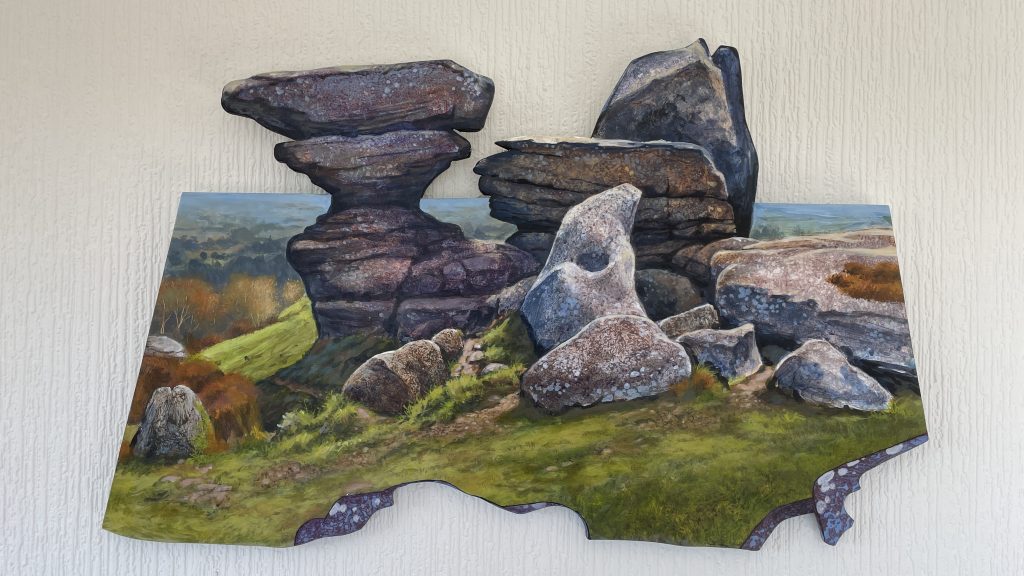
A ‘cut out’ painting of Brimham Rocks. ‘Rock Texturology’ (2018)
Court: Thank you so much for having me over. This place is great. We’re so lucky to live in such a pretty area. I see some familiar places in your landscapes such as Brimham Rocks. Are they all based on actual places? And do you work from photos as reference materials or do you make sketches?
Ray: I have been fascinated by Brimham Rocks ever since I settled in Yorkshire. A great place for walking the dog. I am composition conscious in all my work. I set out to find interesting shapes and groupings of rocks. In this case I did take photos. I also do drawings and sometimes colour thumbnails. I decided to invent interesting skies to set off the landscape. I then painted the scenes in watercolour in a Turner-esque way, using warm and cool colours, some imagination, creating textures, and inventing figures to give scale. Not mere views of a place but a personal interpretation.
Court: Brilliant! I know you’ve said you’ve been painting since you were a teenager, but you didn’t take a traditional path into art via art school. Instead, you did teacher training with a bias towards art. Can you tell us a little more about that and how this may have impacted the work you make?
Ray: I knew nothing of art schools living in a village in the rural Fens of East Anglia. I was encouraged to apply for Trent Park Teacher training college which specialised in music, art and drama. First, I had to do my National Service – this was my real education, changing me from a country yokel to a more worldly wise and experienced young adult.
My teacher-training was 90% theory. The art course added nothing to my existing experience. We had a wonderful place to work, in an orangery, part of the country house college. Though the tutor was totally uninspiring and seemed very old, I had reached a Van Gogh influenced phase when I left school. The tutor disapproved and I had to conform to a more conventional approach to ensure I passed the final assessment which felt like a backward step.
I learned to teach in my teaching job at Coldcotes Boys school. I wondered why no one else had applied for the job and later discovered it was the worst school in Leeds at the time. It was a case of learn to teach or run away screaming!
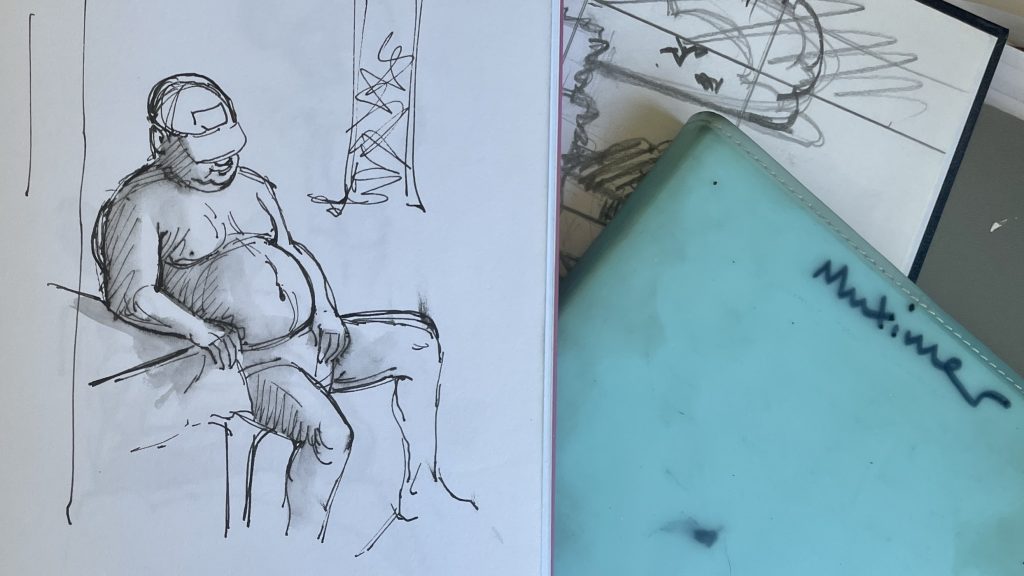
Sketches made whilst on holiday.
Court: That sounds like a challenging situation. You mentioned that you were painting and exhibiting whilst teaching. What sort of work were you making at that time?
Ray: I always had a few paintings in local galleries but because I didn’t depend on sales from my painting I didn’t have to keep a commercial gallery happy so never had to establish a permanent style, or subject identity. So my work has always been a never ending personal exploration of pictorial representation. In teaching, if you pass all of your creative ideas to your students, you dry up as an artist. I had to keep painting to keep my own artistic spirit alive. My work became semi abstract, based on nature; rich in colour texture and pattern. Things seen, sometimes drawn, but transformed by imagination. Mundane subjects – tree trunks, rock surfaces, ripples in water, hedges, turnips in a field. I worked in acrylic which was new and versatile, and in watercolour.
I arranged at least one solo show a year and a had diary of group shows to enter. That was always an incentive to keep me painting.
Court: And so how did you transition from being the head of art at St Aiden’s to working full-time as a freelance illustrator and artist?
Ray: When my son was born, I discovered children’s glorious picture books, suddenly, with new printing technology, in full rich colour, they were works of art in themselves. Brian Wildsmith and Charles Keeping, both artists, produced exciting visual images. I wrote, drew and painted some of my own picture book stories. About 5 illustrated books over 5 years. I received dozens of rejections from publishers. But the illustrations got better each time.
I had met Christine, my wife, at the Training College. She was standing in for a teacher at the local primary school. At the time, the class was watching a Yorkshire Television schools’ program, which was stories with still pictures read by an actor. A Yorkshire TV Education officer was there to observe and she got the details of the producer from him and I took him some of my stories. He liked 3 of them and I redrew the pictures to fit the TV format. He regularly gave me other stories to illustrate after that. I was given a free hand. So I would try out different stories in different media and styles. A good self-training period.
I contacted E.J.Arnold, England’s biggest educational publisher, in Leeds. I convinced the Art Editor, on the basis of my TV work, that I was a brilliant illustrator and was given a set of 4 books to illustrate. After that, I got more work from them, so I had regular clients. I then got an artists’ agent. I had total confidence in my drawing ability and skill. I gave up teaching in 1980. My wife and I made a good team, treating the illustrations as a professional business.
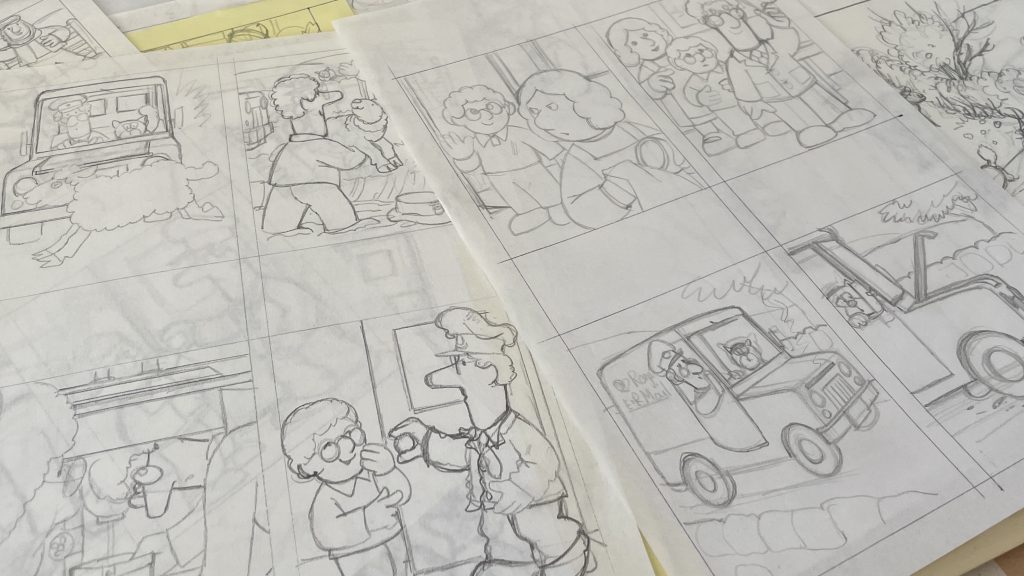
Sketches for Postman Pat.
Court: And then how did you involvement with Postman Pat come about? And what did you create whilst working with them?
Ray: I did a vast range of illustrations over the next decade. Childrens’ books for all ages for various publishers. Pictorial histories for major companies and institutions. Craft pages, designed and written by Christine, for children’s magazines. I still painted for myself when there was a lull. But tight deadlines and pressure of work meant that one-man exhibitions fizzled out. I was always seeking new contacts.
I then had an appointment in Ipswich with a new small publisher. When the editor opened her door she said, “An artists agent has just left me. I’ll run to the car park and see if he is still there”. She brought him back, they both looked over my portfolio, asked questions and said the usual – “if anything suitable crops up I’ll get in touch”. The next day the agent called. He had been to the publisher Andre Deutsch who needed a Postman Pat artist for a new series of books. I bought existing Pat books and DVDs for reference, sent the agent a set of illustrations and I got the job! Publishers of the ‘Postman Pat Annual’ and another of board books for young children were eventually directed to me as THE Postman Part illustrator. I did 42 Pat books in all.
Court: What do you make of the way Postman Pat is created today?
Ray: Ivor Wood, creator of Postman Pat, eventually sold Woodland animations and the characters it owned. The new company made lots of changes, including computer animation, getting rid of poor old Mrs Goggins and the Post Office. The series lost its original old fashioned village life ethos. BBC publications (I drew Pat in their Toybox magazine) rang me to say they could not use me anymore until I was approved by the new company – who had issued a new style guide to follow, showing the characters in a simpler somewhat crude way. They wanted me to draw like that. No Way! I could never betray my friend Pat by changing his look.
Court: Yeah I can see it would have felt very uncomfortable to change him. Thinking about your work as a professional artist and also as an illustrator. Do you see these as separate practices? And do they contribute to one another?
Ray: The ease with which I made the transition from painting to illustration shows that they have a lot in common. My watercolour painting, drawing skills and experience are the basis. Other connections are: colour for mood and atmosphere, dynamic and variable composition, lively drawing, perspective and spatial illusion, and pattern and design. The biggest difference is that illustrators must have a vivid imagination and able to draw from memory.
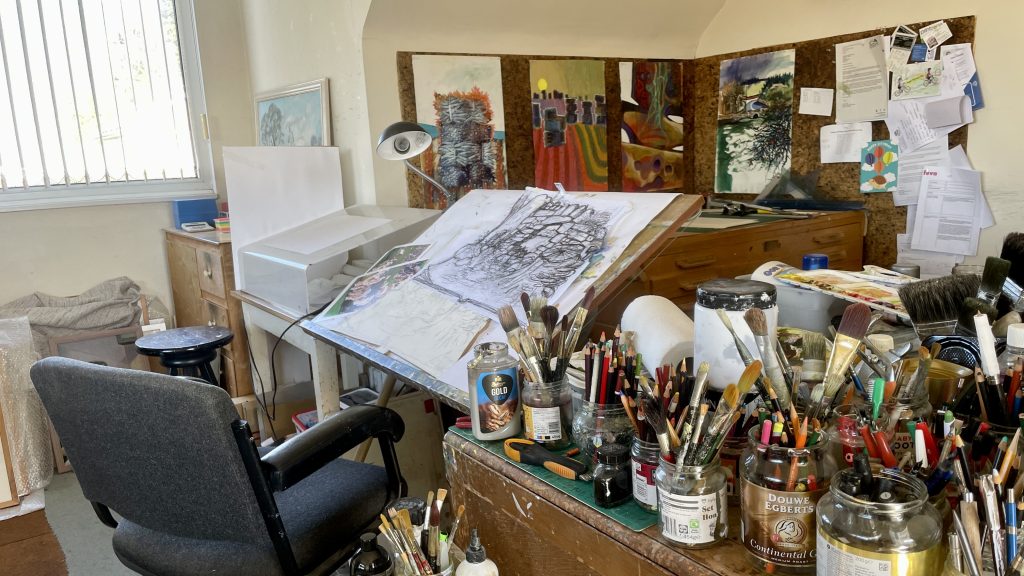
Studio with a ‘cut out’ painting in the early stages of development.
Court: You’ve been fortunate enough to take over the master bedroom for your studio. Can you tell us a bit about your studio? How long have you been here, have you always had a studio at home?
Ray: In the early days of teaching, I had little time to paint and had no need of a studio. I remember painting in the garage. I floored part of the attic and made racks for paintings. I had a Mini Traveller so all my paintings had to be of a size that could fit in the back of that. We moved here in 1981 and I claimed my studio space. I had a large collection of paintings to be housed. By then illustration was my full-time job. We bought a plan-chest and filing cabinets, drawing boards on stands, comfortable adjustable seats, a light box for turning sketches into drawings, a small chest of drawers full of assorted paints, ink, glue etc.
I slowly accumulated a very large collection of books. Reference books for costume, animals etc. and books about classic illustrators like Arthur Rackham. My shelves contain a huge amount of previous work in A2 and A3 folders of original illustrations and paintings and drawings. All these from decades of artwork.
Court: What are you working on at the moment? And how often do you get into the studio?
Ray: I am still painting. I have a few pieces in a local gallery and make the occasional sale. I’m still doing illustrations but for myself and for friends. I am in the studio most days. Sometimes for a short while. I take it all very leisurely. But when a painting is really working, I lose track of time and can spend several continuous days working on it.
I have started a couple of ‘cut outs’ which are shaped paintings without a frame. One is a hedge, the other is a wall and tree stump with fungi. I only have a vague idea where the painting of them will lead me, making decisions as things progress. I am also doing a fantasy water colour of a dragonfly. Two kids have butterfly nets to catch this dragon body with dragonfly wings.
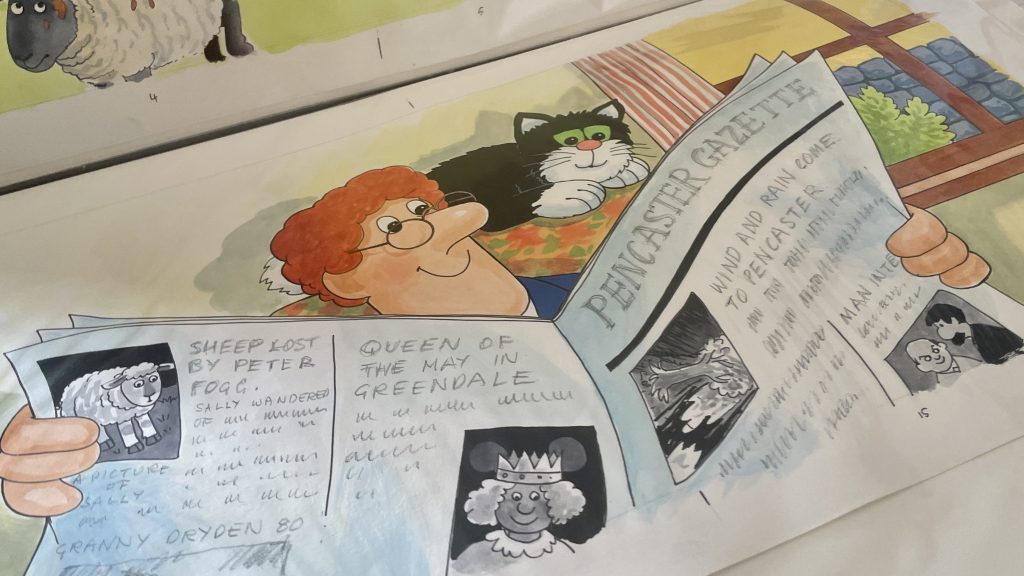
Postman Pat.
Court: What would you say is your career highlight to date?
Ray: Definitely Postman Pat. And perhaps the exhibition of originals I had at National Trust Nunnington Hall in 2012. The artwork would have made more in London illustration galleries, but I have always ensured that folk up north have had the opportunity to own and enjoy them at my many illustration originals exhibitions.
Court: That’s an impressive highlight. Do you have any tips for artists or illustrators just starting out?
Ray: Persistence pays and never let a client down, so always deliver on time.
Court: Good advice. Do you have a dream project you would love to make happen?
Ray: I would love to have a retrospective exhibition, a mixture of paintings, illustration work, and working drawings covering 60 years.
Court: That would be brilliant! Do you have any exhibitions coming up?
Ray: The only one is opening our Home Gallery as part of the Knaresborough Festival, 11 – 20 August. We will have about 150 works on show.
Court: What’s the best way for people to follow your work or get in touch?
Ray: My website is www.raymutimer-artist.co.uk. We will be open for the festival in August but also welcome visitors via appointment which can be made through the contact form on my website. And Wikipedia has a short biography and a full list of my illustrated books.
Court: Fabulous! Thank you so much for your time, I really appreciate it. It’s been such a treat to hear about your work and see so much of it on display here at your home.
Filed under: Art
Tagged with: art, artist, exhibitions, home studio, illustration, illustrator, Knaresborough, Noddy, North, Paddington Bear, painting, perspective, postman pat, prolific, Rupert Bear, snooping through studios, solo exhibitions, Studio, teaching
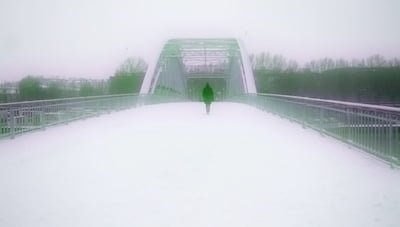

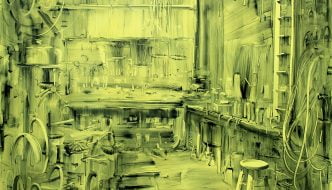
Comments